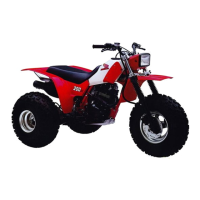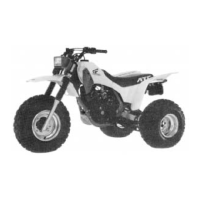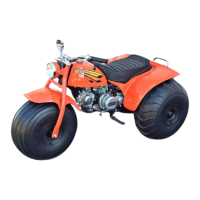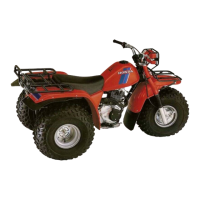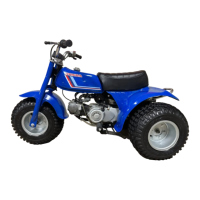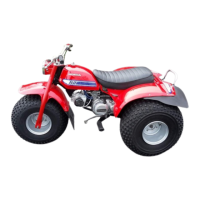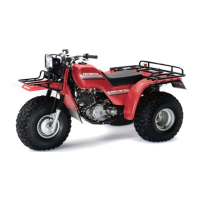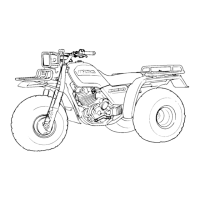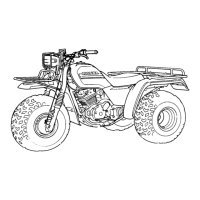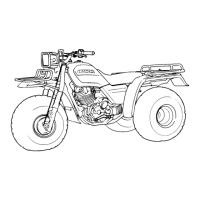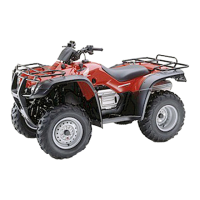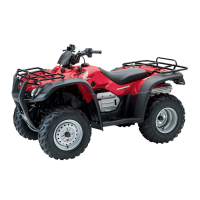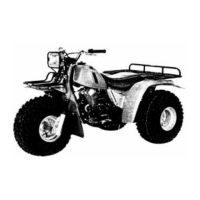
Do you have a question about the Honda ATC200ES 1984 and is the answer not in the manual?
| Brand | Honda |
|---|---|
| Model | ATC200ES 1984 |
| Category | Offroad Vehicle |
| Language | English |
Rules to ensure safe operation, including pre-ride checks, obeying laws, and riding cautiously.
Recommendations for essential protective gear, emphasizing helmet use and covering exposed skin.
Warnings against modifying the ATC or its original equipment, highlighting safety and legality concerns.
Use extreme care when adding accessories and cargo; it reduces stability and performance. Slow down when loaded.
Details maximum combined weight, front/rear carrier limits, and trailer towing specifications.
Diagram identifying key parts of the ATC with numbered labels for reference.
Provides locations for recording frame and engine serial numbers for dealer reference.
Explains the function of the ignition switch and key removal based on position (OFF/ON).
Covers the reverse indicator lamp and the engine stop switch functions.
Covers the starter button and headlight switch operations.
Covers throttle lever operation and brake lever/parking brake functions.
Details the gearshift pedal's function, shifting sequence, and limitations in reverse.
Describes the two indicators that show when the transmission is in neutral, aiding pre-start checks.
Explains the subtransmission selector for drive ratios (L/H) and reverse (R), with operating notes and cautions.
Describes the decompressor lever's function to aid starting with the recoil starter.
Covers choke knob operation for starting and fuse replacement procedures.
Explains the 12V DC receptacle, its fuse, and how to connect accessories using the special plug.
Provides warnings and cautions regarding the use of the 12V DC power supply and accessory connections.
Explains the three positions (OFF, ON, RES) of the fuel valve and their functions.
Details fuel tank capacity, recommended gasoline, and operation of the fuel cap vent lever.
Provides steps for checking engine oil level using the dipstick and maintaining it between marks.
Recommends using Honda 4-stroke oil or equivalent, and details recommended viscosity based on temperature.
Details tire size, recommended inflation pressure, maximum/minimum pressure, and standard circumference.
Warns about the effects of unequal tire pressures and under/overinflation on handling and tire life.
Provides a daily checklist of critical items to inspect before starting the engine for safety and performance.
Details preparation steps before starting the engine, including surface selection, brake, fuel, and neutral confirmation.
Step-by-step guide for starting the engine in normal air temperatures, including choke and throttle use.
Procedure for starting the engine in high air temperatures, noting the omission of choke use.
Instructions for starting the engine in low temperatures, emphasizing warm-up and choke use.
Guide for using the recoil starter if the electric starter fails, including decompressor and preparation steps.
Steps to clear a flooded engine by using the choke, throttle, and starter button.
Advice on breaking in the new engine by varying speed and avoiding high RPMs for longevity.
Emphasizes reviewing safety, avoiding stunts, keeping feet on pegs, and using caution with loads/trailers.
Recommends practicing in a safe, obstacle-free area with an even surface, avoiding paved areas.
Explains how to shift gears progressively, with cautions against shifting without closing the throttle.
Details how to engage and operate the ATC in reverse gear safely, with cautions about stopping.
Explains the technique for turning by shifting body weight and using throttle control for traction.
Provides guidance on correcting front wheel skids and rear wheel slides, and cautions about slippery terrain.
Describes the technique for climbing hills, involving weight transfer and steady speed, with warnings.
Warns against sudden throttle changes or gear shifts on hills and advises on turning on hillsides.
Advises descending hills directly downhill at a slow speed with the throttle closed and proper body position.
Recommends intermittent braking for sand dunes and notes reduced braking effectiveness on loose surfaces.
Explains leaning uphill for balance and stability when riding across slopes, especially on loose surfaces.
Provides guidance on fording water, avoiding fast streams, and checking/drying brakes afterward.
Warns against fast-flowing water and exceeding the ATC's depth limit, and cautions about brake performance.
Explains how high altitude affects the air-fuel mixture and performance, suggesting carburetor modifications.
Steps for safely parking the ATC, including transmission neutral, shutting off systems, and engaging the parking brake.
Details initial and regular service periods for various components like engine oil, filters, and spark plugs.
Lists service intervals for battery, valve clearance, carburetor, fuel system, brakes, and more.
Lists the tools provided in the kit for routine maintenance and simple repairs.
Provides step-by-step instructions for draining engine oil, including removing the drain plug and oil filter screen.
Details the procedure for removing, cleaning, and reinstalling the oil filter rotor.
Explains how to service the incorporated fuel filter, including draining fuel and cleaning the filter.
Provides steps for adjusting idle speed and fuel mixture using the throttle stop and pilot screws.
Details carburetor modifications for high altitude, including jet and needle changes, with cautions.
Explains how to inspect spark plug electrodes, check and adjust the spark plug gap.
Details the procedure for removing, cleaning, and oiling the air cleaner element.
Explains how to check valve clearances when the engine is cold using a feeler gauge.
Details the process of adjusting valve clearance by loosening lock nuts and turning adjusting screws.
Outlines the steps for adjusting clutch free play by loosening and tightening the lock nut and adjuster.
Explains how to measure and adjust free play on the front brake lever using cable adjusters.
Details how to measure and adjust free play on the rear brake pedal using the adjusting nut.
Explains adjusting rear brake lever free play and using the parking brake feature.
Details how to inspect, lubricate, and adjust throttle cable free play using the adjuster.
Provides steps for draining, filling, and checking final drive oil level, including drain plug torque.
Explains how to adjust cam chain tension by loosening and retightening the tensioner adjusting bolt.
Details how to check battery electrolyte level and add distilled water if needed, with cautions.
Provides critical safety warnings regarding sulfuric acid, explosive gases, and handling the battery.
Explains how to purge accumulated carbon from the exhaust system by cleaning the diffuser.
Details steps to prepare the ATC for extended storage, including oil change, fuel draining, and battery removal.
Provides instructions for removing the ATC from storage, including cleaning, fluid checks, and pre-ride checks.
Details steps for preparing the ATC for transport, including fuel draining, battery removal, and inclining warnings.
Step-by-step guide for removing the front wheel, including brake cable disconnection and axle removal.
Provides instructions for installing the front wheel, tightening the axle nut, and adjusting the brake lever.
Details the steps for removing the rear wheel, including loosening wheel nuts.
Explains federal laws prohibiting tampering with the noise control system and defines acts of tampering.
Lists overall dimensions, weight, engine oil capacity, fuel tank capacity, and passenger capacity.
Details engine bore/stroke, compression ratio, displacement, spark plug gap, valve clearance, and gear ratios.
Provides a detailed wiring diagram showing connections between electrical components and switches.
Illustrates various optional parts and accessories available for the ATC, such as baskets and covers.
Guides owners on resolving satisfaction issues with dealers and contacting customer relations.
